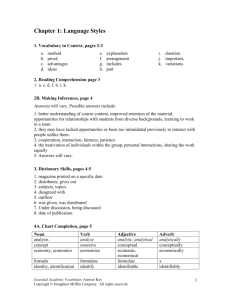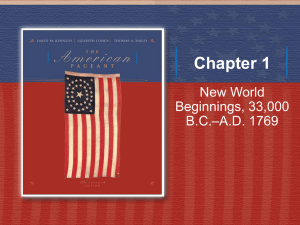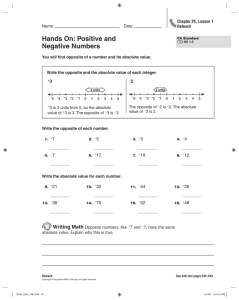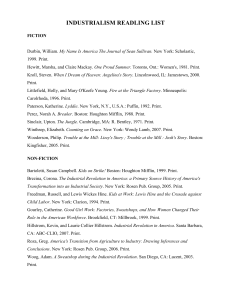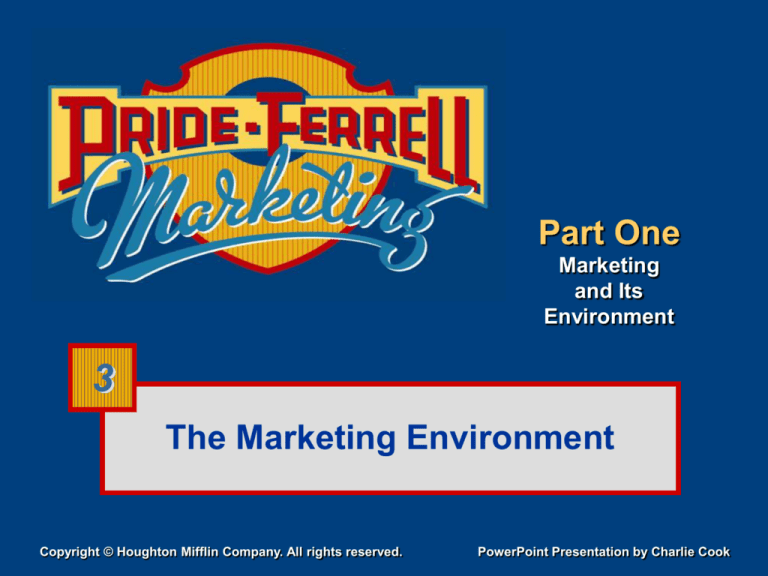
Part One
Marketing
and Its
Environment
3
The Marketing Environment
Copyright © Houghton Mifflin Company. All rights reserved.
PowerPoint Presentation by Charlie Cook
Chapter Learning Objectives
• To recognize the importance of environmental scanning
and analysis
• To understand how competitive and economic factors affect
organizations’ ability to compete and customers’ ability and
willingness to buy products
• To identify the types of political forces in the marketing
environment
• To understand how laws, government regulations, and selfregulatory agencies affect marketing activities
• To explore the effects of new technology on society and on
marketing activities
• To analyze sociocultural issues that marketers must deal
with as they make decisions
Copyright © Houghton Mifflin Company. All rights reserved.
3–2
Chapter Outline
• Examining and Responding to the Marketing
Environment
• Competitive Forces
• Economic Forces
• Political Forces
• Legal and Regulatory Forces
• Technological Forces
• Sociocultural Forces
Copyright © Houghton Mifflin Company. All rights reserved.
3–3
Examining and Responding to the
Marketing Environment
• Environmental Scanning
–The process of collecting information about forces in
the marketing environment
• Observation
• Secondary sources
• Market research
• Environmental Analysis
–The process of assessing and interpreting the
information gathered through environmental scanning
• Accuracy
• Consistency
• Significance
Copyright © Houghton Mifflin Company. All rights reserved.
3–4
Examining and Responding to the
Marketing Environment (cont’d)
• Responding to Environmental Forces
–Reactive approach
• Passive view of environment as uncontrollable
• Current strategy is cautiously adjusted to accommodate
environmental changes
–Proactive approach
• Actively attempts to shape and influence environment
• Strategies are constructed to overcome market challenges
and take advantage of opportunities
Copyright © Houghton Mifflin Company. All rights reserved.
3–5
Competitive Forces
Types of Competition
Competition
Other organizations that market products that
are similar to or can be substituted for a
marketer’s products in same geographic area
Brand competitors
Firms that market products with similar
features and benefits to the same customers
at similar prices
Generic competitors
Firms that provide very different products that
solve the same problem or satisfy the same
basic customer need
Total budget
competitors
Firms that compete for the limited financial
resources of the same customers
Copyright © Houghton Mifflin Company. All rights reserved.
3–6
TABLE 3.1
Copyright © Houghton Mifflin Company. All rights reserved.
3–7
Competitive Forces (cont’d)
• Monitoring Competition
–Helps determine competitors’ strategies and their
effects on firm’s strategies
–Guides development of competitive advantage and
adjusting firm’s strategy
–Provides ongoing information about competitors
–Assists in maintaining a marketing orientation
Copyright © Houghton Mifflin Company. All rights reserved.
3–8
Economic Forces
• Business Cycle
Positive Economic Indicators
–A pattern of economic fluctuations that has four stages:
Prosperity
Recovery
Recession
Depression
Time
Copyright © Houghton Mifflin Company. All rights reserved.
3–9
Economic Forces (cont’d)
Stages in the Business Cycle
Prosperity
Low unemployment and high total income
create high buying power
Recession
Rising unemployment reduces total buying
power; consumer and business spending
decline
Depression
Unemployment extremely high, wages and
total disposable income are very low, and
there is a lack of consumer confidence
Recovery
Economy is moving out of recession or
depression towards prosperity
Copyright © Houghton Mifflin Company. All rights reserved.
3–10
Economic Forces (cont’d)
• Buying Power
–Resources, such as money, goods, and services, that
can be traded in an exchange
–Income
• Disposable income
• Discretionary income
–Wealth
Copyright © Houghton Mifflin Company. All rights reserved.
3–11
American Customer Satisfaction Index
Source: “American Customer Satisfaction Index, “ University of Michigan Business
School, May 21, 2001, www.bus.umich.edu/research/nqrc/natscores.html.
Copyright © Houghton Mifflin Company. All rights reserved.
FIGURE 3.1
3–12
Economic Forces (cont’d)
• Willingness to Spend
–An inclination to buy because of expected satisfaction
from a product, influenced by the ability to buy and
numerous psychological and social forces
–Expectations influencing the willingness to spend:
•
•
•
•
•
Future employment
Income levels
Prices
Family size
General economic conditions (e.g., rising prices)
Copyright © Houghton Mifflin Company. All rights reserved.
3–13
Political Forces
• Reasons for Maintaining Relations with Elected
Officials and Politicians
–To influence the creation of laws and regulations
affecting industries and specific businesses
–Governments are potentially large customers
–Political officials can assist in securing foreign markets
–Campaign contributions of corporate-related individuals
and political action committees may provide influence
–Lobbyists work to communicate businesses’ concerns
about issues affecting their industries and markets
Copyright © Houghton Mifflin Company. All rights reserved.
3–14
Legal and Regulatory Forces
• Sherman Antitrust Act (1890)
• Clayton Act (1914)
• Federal Trade
Commission Act (1914)
• Robinson-Patman Act (1936)
• Wheeler-Lea Act (1938)
• Lanham Act (1946)
• Celler-Kefauver Act (1950)
• Fair Packaging and Labeling Act (1966)
Copyright © Houghton Mifflin Company. All rights reserved.
3–15
Legal and Regulatory Forces (cont’d)
• Magnuson-Moss Warranty (FTC) Act (1975)
• Consumer Goods Pricing Act (1975)
• Antitrust Improvements Act (1976)
• Trademark Counterfeiting Act (1980)
• Trademark Law Revision Act (1988)
• Nutrition Labeling and Education Act (1990)
• Telephone Consumer Protection Act (1991)
• Federal Trademark Dilution Act (1995)
• Digital Millennium Copyright Act (1995)
• Children’s Online Privacy Protection Act (2000)
Copyright © Houghton Mifflin Company. All rights reserved.
3–16
Legal and Regulatory Forces (cont’d)
• Procompetitive Legislation
–Laws designed to:
• preserve competition
• prevent the restraint of trade and the
monopolizing of markets
• prevent illegal competitive trade practices
• Consumer Protection Legislation
–Laws enacted to protect customers from:
• adulterated and mislabeled food and drugs
• deceptive trade practices and the sale of hazardous
products
• the invasion of personal privacy and the misuse of
personal information by firms
Copyright © Houghton Mifflin Company. All rights reserved.
3–17
Legal and Regulatory Forces (cont’d)
• Encouraging Compliance with Laws and
Regulations
–Movement is toward greater organizational
accountability for misconduct of employees.
• Regulatory Agencies
–Federal Trade Commission (FTC) influences marketing
activities most; can seek civil penalties
and require corrective advertising
• Self-Regulatory Forces
–Better Business Bureau
–National Advertising Review
Board (NARB)
Copyright © Houghton Mifflin Company. All rights reserved.
3–18
Copyright © Houghton Mifflin Company. All rights reserved.
3–19
Technological Forces
• Technology
–The application of knowledge and tools to solve
problems and perform tasks more efficiently
• Impact of Technology
–Dynamic means constant change
–Reach refers to how technology
quickly moves through society.
–The self-sustaining nature of
technology as the catalyst
for even faster development
Copyright © Houghton Mifflin Company. All rights reserved.
3–20
Technological Forces (cont’d)
• Adoption and Use of Technology
–Failing to adopt new technology can cause a loss of
market leadership.
–Protecting the firm’s inventions is critical.
–Using a technology assessment allows
the firm to foresee the effects
of new products and
processes on the firm.
Copyright © Houghton Mifflin Company. All rights reserved.
3–21
Top Ten
Activities
for Wireless
Web Device
Users
Source: “New Survey Indicates Wireless Web
Penetration Highest among Young Affluent Males,”
TNS Intersearch, press release, Feb. 7, 2001,
http://www.intersearch.tnsofres.com/.
Copyright © Houghton Mifflin Company. All rights reserved.
FIGURE 3.2
3–22
Sociocultural Forces
• Sociocultural Forces
–The influences in a society and its culture(s) that
change people’s attitudes, beliefs, norms, customs, and
lifestyles
• Demographic Diversity and Characteristics
–Increasing proportion of older consumers
–Rising number of single adults
–Entering another baby boom
–Increasingly multicultural U.S. society
Copyright © Houghton Mifflin Company. All rights reserved.
3–23
U.S. Population Projections by Race
Source: Bureau of the Census, Statistical Abstract of the United States, 2000
(Washington, DC: Government Printing Office, 2001), p. 17.
Copyright © Houghton Mifflin Company. All rights reserved.
FIGURE 3.3
3–24
Sociocultural Forces (cont’d)
• Cultural Values
–Primary source of values is the family
–Values influence:
•
•
•
•
Eating habits (healthier foods)
Alternative health and medical treatment choices
Attitudes toward marriage
Concern for the natural environment
• Consumerism
–Organized efforts by individuals, groups, and
organizations to protect consumers’ rights
Copyright © Houghton Mifflin Company. All rights reserved.
3–25
After reviewing this chapter you should:
• Recognize the importance of environmental scanning and
analysis.
• Understand how competitive and economic factors affect
organizations’ ability to compete and customers’ ability and
willingness to buy products.
• Be able to identify the types of political forces in the
marketing environment.
• Understand how laws, government regulations, and selfregulatory agencies affect marketing activities.
• Know the effects of new technology on society and on
marketing activities.
• Be able to analyze sociocultural issues that marketers must
deal with as they make decisions.
Copyright © Houghton Mifflin Company. All rights reserved.
3–26
Chapter 3
Supplemental Slides
Copyright © Houghton Mifflin Company. All rights reserved.
3–27
Key Terms and Concepts
• The following slides (a listing of terms and
concepts) are intended for use at the instructor’s
discretion.
• To rearrange the slide order or alter the content
of the presentation
–select “Slide Sorter” under View on the main menu.
–left click on an individual slide to select it; hold and drag
the slide to a new position in the slide show.
–To delete an individual slide, click on the slide to select,
and press the Delete key.
–Select “Normal” under View on the main menu to return
to normal view.
Copyright © Houghton Mifflin Company. All rights reserved.
3–28
Important Terms
• Environmental Scanning
–The process of collecting information about forces in
the marketing environment
• Environmental Analysis
–The process of assessing and interpreting the
information gathered through environmental scanning
• Competition
–Other organizations that market products that are
similar to or can be substituted for a marketer’s
products in same geographic area
Copyright © Houghton Mifflin Company. All rights reserved.
3–29
Important Terms
• Brand Competitors
–Firms that market products with similar features and
benefits to the same customers at similar prices
• Generic Competitors
–Firms that provide very different products that solve the
same problem or satisfy the same basic customer need
• Total Budget Competitors
–Firms that compete for the limited financial resources of
the same customers
• Business Cycle
–A pattern of economic fluctuations that has four stages:
prosperity, recession, depression, and recovery
Copyright © Houghton Mifflin Company. All rights reserved.
3–30
Important Terms
• Buying Power
–Resources, such as money, goods, and services, that
can be traded in an exchange
• Willingness to Spend
–An inclination to buy because of expected satisfaction
from a product, influenced by the ability to buy and
numerous psychological and social forces
Copyright © Houghton Mifflin Company. All rights reserved.
3–31
Important Terms
• Sherman Antitrust Act (1890)
• Clayton Act (1914)
• Federal Trade
Commission Act (1914)
• Robinson-Patman Act (1936)
• Wheeler-Lea Act (1938)
• Lanham Act (1946)
• Celler-Kefauver Act (1950)
• Fair Packaging and Labeling Act (1966)
Copyright © Houghton Mifflin Company. All rights reserved.
3–32
Important Terms
• Magnuson-Moss Warranty (FTC) Act (1975)
• Consumer Goods Pricing Act (1975)
• Antitrust Improvements Act (1976)
• Trademark Counterfeiting Act (1980)
• Trademark Law Revision Act (1988)
• Nutrition Labeling and Education Act (1990)
• Telephone Consumer Protection Act (1991)
• Federal Trademark Dilution Act (1995)
• Digital Millennium Copyright Act (1995)
• Children’s Online Privacy Protection Act (2000)
Copyright © Houghton Mifflin Company. All rights reserved.
3–33
Important Terms
• Technology
–The application of knowledge and tools to solve
problems and perform tasks more efficiently
• Sociocultural Forces
–The influences in a society and its culture(s) that
change people’s attitudes, beliefs, norms, customs, and
lifestyles
• Cultural Values
–Primary source of values is the family
• Consumerism
–Organized efforts by individuals, groups, and
organizations to protect consumers’ rights
Copyright © Houghton Mifflin Company. All rights reserved.
3–34
Transparency Figure 3D
Ranking Products Consumers Would Cut Back
on if Spending Decreased
Source: USA Today, October 1, 2001 p. 3D. Used by permission.
Copyright © Houghton Mifflin Company. All rights reserved.
3–35
Transparency Figure 3E
Average U.S. Family Income
• According to the 2000 Census, the
average U.S. family earned $63,410
annually, and the breakdown of earnings
was:
Less than $15,000
10.4%
$15,000–$34,999
23.3%
$35,000–$49,999
16.8%
$50,000–$74,999
22.0%
$75,000–$99,999
12.3%
$100,000–$149,999
9.7%
$150,000+
5.5%
Source: 2000 U.S. Census.
Copyright © Houghton Mifflin Company. All rights reserved.
3–36
Transparency Figure 3G
Purchasing Behavior of Engaged vs. Single
Women
.
Source: American Demographics, May 2001, p.13. Adapted with permission.
Copyright © Houghton Mifflin Company. All rights reserved.
3–37
Transparency Figure 3H
U.S. Poverty Rates for Minorities
Source: USA Today, October 10, 2001 p.A1. Used by permission.
Copyright © Houghton Mifflin Company. All rights reserved.
3–38

